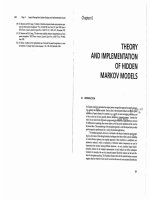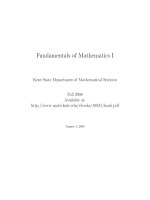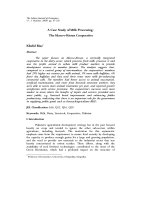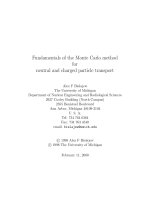Fundamentals of signal processing
Bạn đang xem bản rút gọn của tài liệu. Xem và tải ngay bản đầy đủ của tài liệu tại đây (331.71 KB, 27 trang )
Fundamentals of Signal Processing
Biên tập bởi:
Minh N. Do
Fundamentals of Signal Processing
Biên tập bởi:
Minh N. Do
Các tác giả:
Minh N. Do
Stephen Kruzick
Don Johnson
Phiên bản trực tuyến:
/>
MỤC LỤC
1. Introduction to Fundamentals of Signal Processing
2. Foundations
2.1. Signals Represent Information
2.2. Introduction to Systems
2.3. Discrete-Time Signals and Systems
2.4. Systems in the Time-Domain
2.5. Discrete Time Convolution
Tham gia đóng góp
1/25
Introduction to Fundamentals of Signal
Processing
What is Digital Signal Processing?
To understand what is Digital Signal Processing (DSP) let’s examine what does each of
its words mean. “Signal” is any physical quantity that carries information. “Processing”
is a series of steps or operations to achieve a particular end. It is easy to see that
Signal Processing is used everywhere to extract information from signals or to convert
information-carrying signals from one form to another. For example, our brain and ears
take input speech signals, and then process and convert them into meaningful words.
Finally, the word “Digital” in Digital Signal Processing means that the process is done
by computers, microprocessors, or logic circuits.
The field DSP has expanded significantly over that last few decades as a result of rapid
developments in computer technology and integrated-circuit fabrication. Consequently,
DSP has played an increasingly important role in a wide range of disciplines in science
and technology. Research and development in DSP are driving advancements in many
high-tech areas including telecommunications, multimedia, medical and scientific
imaging, and human-computer interaction.
To illustrate the digital revolution and the impact of DSP, consider the development
of digital cameras. Traditional film cameras mainly rely on physical properties of
the optical lens, where higher quality requires bigger and larger system, to obtain
good images. When digital cameras were first introduced, their quality were inferior
compared to film cameras. But as microprocessors become more powerful, more
sophisticated DSP algorithms have been developed for digital cameras to correct optical
defects and improve the final image quality. Thanks to these developments, the quality
of consumer-grade digital cameras has now surpassed the equivalence in film cameras.
As further developments for digital cameras attached to cell phones (cameraphones),
where due to small size requirements of the lenses, these cameras rely on DSP power to
provide good images. Essentially, digital camera technology uses computational power
to overcome physical limitations. We can find the similar trend happens in many other
applications of DSP such as digital communications, digital imaging, digital television,
and so on.
In summary, DSP has foundations on Mathematics, Physics, and Computer Science, and
can provide the key enabling technology in numerous applications.
2/25
Overview of Key Concepts in Digital Signal Processing
The two main characters in DSP are signals and systems. A signal is defined as any
physical quantity that varies with one or more independent variables such as time (onedimensional signal), or space (2-D or 3-D signal). Signals exist in several types. In
the real-world, most of signals are continuous-time or analog signals that have values
continuously at every value of time. To be processed by a computer, a continuous-time
signal has to be first sampled in time into a discrete-time signal so that its values at a
discrete set of time instants can be stored in computer memory locations. Furthermore,
in order to be processed by logic circuits, these signal values have to be quantized
in to a set of discrete values, and the final result is called a digital signal. When the
quantization effect is ignored, the terms discrete-time signal and digital signal can be
used interchangeability.
In signal processing, a system is defined as a process whose input and output are
signals. An important class of systems is the class of linear time-invariant (or shiftinvariant) systems. These systems have a remarkable property is that each of them can
be completely characterized by an impulse response function (sometimes is also called
as point spread function), and the system is defined by a convolution (also referred to
as a filtering) operation. Thus, a linear time-invariant system is equivalent to a (linear)
filter. Linear time-invariant systems are classified into two types, those that have finiteduration impulse response (FIR) and those that have an infinite-duration impulse
response (IIR).
A signal can be viewed as a vector in a vector space. Thus, linear algebra provides
a powerful framework to study signals and linear systems. In particular, given a vector
space, each signal can be represented (or expanded) as a linear combination of
elementary signals. The most important signal expansions are provided by the Fourier
transforms. The Fourier transforms, as with general transforms, are often used
effectively to transform a problem from one domain to another domain where it is
much easier to solve or analyze. The two domains of a Fourier transform have physical
meaning and are called the time domain and the frequency domain.
Sampling, or the conversion of continuous-domain real-life signals to discrete
numbers that can be processed by computers, is the essential bridge between the analog
and the digital worlds. It is important to understand the connections between signals and
systems in the real world and inside a computer. These connections are convenient to
analyze in the frequency domain. Moreover, many signals and systems are specified by
their frequency characteristics.
Because any linear time-invariant system can be characterized as a filter, the design
of such systems boils down to the design the associated filters. Typically, in the filter
design process, we determine the coefficients of an FIR or IIR filter that closely
3/25
approximates the desired frequency response specifications. Together with Fourier
transforms, the z-transform provides an effective tool to analyze and design digital
filters.
In many applications, signals are conveniently described via statistical models as
random signals. It is remarkable that optimum linear filters (in the sense of minimum
mean-square error), so called Wiener filters, can be determined using only secondorder statistics (autocorrelation and crosscorrelation functions) of a stationary
process. When these statistics cannot be specified beforehand or change over time,
we can employ adaptive filters, where the filter coefficients are adapted to the signal
statistics. The most popular algorithm to adaptively adjust the filter coefficients is the
least-mean square (LMS) algorithm.
4/25
Foundations
Signals Represent Information
Whether analog or digital, information is represented by the fundamental quantity in
electrical engineering: the signal. Stated in mathematical terms, a signal is merely a
function. Analog signals are continuous-valued; digital signals are discrete-valued. The
independent variable of the signal could be time (speech, for example), space (images),
or the integers (denoting the sequencing of letters and numbers in the football score).
Analog Signals
Analog signals are usually signals defined over continuous independent variable(s).
Speech is produced by your vocal cords exciting acoustic resonances in your vocal
tract. The result is pressure waves propagating in the air, and the speech signal thus
corresponds to a function having independent variables of space and time and a value
corresponding to air pressure: s (x, t) (Here we use vector notation x to denote spatial
coordinates). When you record someone talking, you are evaluating the speech signal
at a particular spatial location, x0 say. An example of the resulting waveform s (x0, t) is
shown in this figure.
Speech Example
5/25
A
speech signal's amplitude relates to tiny air pressure variations. Shown is a recording of
the vowel "e" (as in "speech").
Photographs are static, and are continuous-valued signals defined over space. Blackand-white images have only one value at each point in space, which amounts to its
optical reflection properties. In [link], an image is shown, demonstrating that it (and all
other images as well) are functions of two independent spatial variables.
Lena
6/25
7/25
On the left is the classic Lena image, which is used ubiquitously as a test image. It
contains straight and curved lines, complicated texture, and a face. On the right is a
perspective display of the Lena image as a signal: a function of two spatial variables.
The colors merely help show what signal values are about the same size. In this image,
signal values range between 0 and 255; why is that?
Color images have values that express how reflectivity depends on the optical spectrum.
Painters long ago found that mixing together combinations of the so-called primary
colors--red, yellow and blue--can produce very realistic color images. Thus, images
today are usually thought of as having three values at every point in space, but a different
set of colors is used: How much of red, green and blue is present. Mathematically, color
pictures are multivalued--vector-valued--signals: s (x) = (r (x), g (x), b (x)).
Interesting cases abound where the analog signal depends not on a continuous variable,
such as time, but on a discrete variable. For example, temperature readings taken
every hour have continuous--analog--values, but the signal's independent variable is
(essentially) the integers.
Digital Signals
The word "digital" means discrete-valued and implies the signal has an integer-valued
independent variable. Digital information includes numbers and symbols (characters
typed on the keyboard, for example). Computers rely on the digital representation of
information to manipulate and transform information. Symbols do not have a numeric
value, and each is represented by a unique number. The ASCII character code has the
upper- and lowercase characters, the numbers, punctuation marks, and various other
symbols represented by a seven-bit integer. For example, the ASCII code represents the
letter a as the number 97 and the letter A as 65. [link] shows the international convention
on associating characters with integers.
ASCII Table The ASCII translation table shows how standard keyboard
characters are represented by integers. In pairs of columns, this table
displays first the so-called 7-bit code (how many characters in a seven-bit
code?), then the character the number represents. The numeric codes are
represented in hexadecimal (base-16) notation. Mnemonic characters
correspond to control characters, some of which may be familiar (like cr for
carriage return) and some not (bel means a "bell").
00 nul 01 soh 02 stx 03 etx 04 eot 05 enq 06 ack 07 bel
08 bs
09 ht
0A nl
0B vt
0C np
0D cr
0E so
0F si
10 dle 11 dc1 12 dc2 13 dc3 14 dc4 15 nak 16 syn 17 etb
18 car 19 em 1A sub 1B esc 1C fs
1D gs
1E rs
1F us
8/25
20 sp
21 !
22 "
23 #
24 $
25 %
26 &
27 '
28 (
29 )
2A *
2B +
2C ,
2D -
2E .
2F /
30 0
31 1
32 2
33 3
34 4
35 5
36 6
37 7
38 8
39 9
3A :
3B ;
3C <
3D =
3E >
3F ?
40 @
41 A
42 B
43 C
44 D
45 E
46 F
47 G
48 H
49 I
4A J
4B K
4C L
4D M
4E N
4F 0
50 P
51 Q
52 R
53 S
54 T
55 U
56 V
57 W
58 X
59 Y
5A Z
5B [
5C \
5D ]
5E ^
5F _
60 '
61 a
62 b
63 c
64 d
65 e
66 f
67 g
68 h
69 i
6A j
6B k
6C l
6D m
6E n
6F o
70 p
71 q
72 r
73 s
74 t
75 u
76 v
77 w
78 x
79 y
7A z
7B {
7C |
7D }
7E ~
7F del
9/25
Introduction to Systems
Signals are manipulated by systems. Mathematically, we represent what a system does
by the notation y (t) = S (x (t)), with x representing the input signal and y the output
signal.
Definition of a system
The system depicted has input x (t) and output y (t).
Mathematically, systems operate on function(s) to produce other function(s). In many
ways, systems are like functions, rules that yield a value for the dependent variable
(our output signal) for each value of its independent variable (its input signal). The
notation y (t) = S (x (t)) corresponds to this block diagram. We term S (·) the inputoutput relation for the system.
This notation mimics the mathematical symbology of a function: A system's input is
analogous to an independent variable and its output the dependent variable. For the
mathematically inclined, a system is a functional: a function of a function (signals are
functions).
Simple systems can be connected together--one system's output becomes another's
input--to accomplish some overall design. Interconnection topologies can be quite
complicated, but usually consist of weaves of three basic interconnection forms.
Cascade Interconnection
cascade
The most rudimentary ways of interconnecting systems are shown in the figures in this section.
This is the cascade configuration.
The simplest form is when one system's output is connected only to another's input.
Mathematically, w (t) = S1 (x (t)), and y (t) = S2 (w (t)), with the information contained
in x (t) processed by the first, then the second system. In some cases, the ordering of
the systems matter, in others it does not. For example, in the fundamental model of
communication the ordering most certainly matters.
10/25
Parallel Interconnection
parallel
The parallel configuration.
A signal x (t) is routed to two (or more) systems, with this signal appearing as the
input to all systems simultaneously and with equal strength. Block diagrams have the
convention that signals going to more than one system are not split into pieces along
the way. Two or more systems operate on x (t) and their outputs are added together to
create the output y (t). Thus, y (t) = S1 (x (t)) + S2 (x (t)), and the information in x (t) is
processed separately by both systems.
Feedback Interconnection
feedback
The feedback configuration.
The subtlest interconnection configuration has a system's output also contributing to
its input. Engineers would say the output is "fed back" to the input through system
2, hence the terminology. The mathematical statement of the feedback interconnection
is that the feed-forward system produces the output: y (t) = S1 (e (t)). The input e (t)
equals the input signal minus the output of some other system's output to y (t):
e (t) = x (t) − S2 (y (t)). Feedback systems are omnipresent in control problems, with
the error signal used to adjust the output to achieve some condition defined by the
input (controlling) signal. For example, in a car's cruise control system, x (t) is a
constant representing what speed you want, and y (t) is the car's speed as measured by a
speedometer. In this application, system 2 is the identity system (output equals input).
11/25
Discrete-Time Signals and Systems
Mathematically, analog signals are functions having as their independent variables
continuous quantities, such as space and time. Discrete-time signals are functions
defined on the integers; they are sequences. As with analog signals, we seek ways
of decomposing discrete-time signals into simpler components. Because this approach
leading to a better understanding of signal structure, we can exploit that structure to
represent information (create ways of representing information with signals) and to
extract information (retrieve the information thus represented). For symbolic-valued
signals, the approach is different: We develop a common representation of all symbolicvalued signals so that we can embody the information they contain in a unified way.
From an information representation perspective, the most important issue becomes, for
both real-valued and symbolic-valued signals, efficiency: what is the most parsimonious
and compact way to represent information so that it can be extracted later.
Real- and Complex-valued Signals
A discrete-time signal is represented symbolically as s (n), where n = {…, -1, 0, 1, …}
.
Cosine
The discrete-time cosine signal is plotted as a stem plot. Can you find the formula for this
signal?
We usually draw discrete-time signals as stem plots to emphasize the fact they are
functions defined only on the integers. We can delay a discrete-time signal by an
integer just as with analog ones. A signal delayed by m samples has the expression
s (n − m ).
Complex Exponentials
The most important signal is, of course, the complex exponential sequence.
s (n) = ei2πfn
Note that the frequency variable f is dimensionless and that adding an integer to the
frequency of the discrete-time complex exponential has no effect on the signal's value.
ei2π(f + m)n = ei2πfnei2πmn = ei2πfn
12/25
This derivation follows because the complex exponential evaluated at an integer
multiple of 2π equals one. Thus, we need only consider frequency to have a value in
some unit-length interval.
Sinusoids
Discrete-time sinusoids have the obvious form s (n) = A(cos (2πfn + φ)). As opposed
to analog complex exponentials and sinusoids that can have their frequencies be any
real value, frequencies of their discrete-time counterparts yield unique waveforms only
1 1
when f lies in the interval − 2 , 2 . This choice of frequency interval is arbitrary; we
(
]
can also choose the frequency to lie in the interval [0, 1). How to choose a unit-length
interval for a sinusoid's frequency will become evident later.
Unit Sample
The second-most important discrete-time signal is the unit sample, which is defined to
be
δ (n) =
{
1 if n = 0
0 otherwise
Unit sample
The unit sample.
Examination of a discrete-time signal's plot, like that of the cosine signal shown in
[link], reveals that all signals consist of a sequence of delayed and scaled unit samples.
Because the value of a sequence at each integer m is denoted by s (m) and the unit
sample delayed to occur at m is written δ (n − m), we can decompose any signal as a
sum of unit samples delayed to the appropriate location and scaled by the signal value.
∞
s (n) = ∑m = −∞ ((s (m))(δ (n − m)))
This kind of decomposition is unique to discrete-time signals, and will prove useful
subsequently.
Unit Step
The unit sample in discrete-time is well-defined at the origin, as opposed to the situation
with analog signals.
13/25
u (n) =
{
1 if n ≥ 0
0 if n < 0
Symbolic Signals
An interesting aspect of discrete-time signals is that their values do not need to be
real numbers. We do have real-valued discrete-time signals like the sinusoid, but we
also have signals that denote the sequence of characters typed on the keyboard. Such
characters certainly aren't real numbers, and as a collection of possible signal values,
they have little mathematical structure other than that they are members of a set.
More formally, each element of the symbolic-valued signal s (n) takes on one of the
values {a1, …, aK} which comprise the alphabet A. This technical terminology does not
mean we restrict symbols to being members of the English or Greek alphabet. They
could represent keyboard characters, bytes (8-bit quantities), integers that convey daily
temperature. Whether controlled by software or not, discrete-time systems are ultimately
constructed from digital circuits, which consist entirely of analog circuit elements.
Furthermore, the transmission and reception of discrete-time signals, like e-mail, is
accomplished with analog signals and systems. Understanding how discrete-time and
analog signals and systems intertwine is perhaps the main goal of this course.
Discrete-Time Systems
Discrete-time systems can act on discrete-time signals in ways similar to those found
in analog signals and systems. Because of the role of software in discrete-time systems,
many more different systems can be envisioned and "constructed" with programs than
can be with analog signals. In fact, a special class of analog signals can be converted into
discrete-time signals, processed with software, and converted back into an analog signal,
all without the incursion of error. For such signals, systems can be easily produced in
software, with equivalent analog realizations difficult, if not impossible, to design.
14/25
Systems in the Time-Domain
A discrete-time signal s (n) is delayed by n0 samples when we write s (n − n0), with
n0 > 0. Choosing n0 to be negative advances the signal along the integers. As opposed to
analog delays, discrete-time delays can only be integer valued. In the frequency domain,
delaying a signal corresponds to a linear phase shift of the signal's discrete-time Fourier
transform:
↔ (s (n − n ), e
0
(S (ei2πf))).
−i2πfn0
Linear discrete-time systems have the superposition property.
Superposition
S (a1(x1 (n)) + a2(x2 (n))) = a1(S (x1 (n))) + a2(S (x2 (n)))
A discrete-time system is called shift-invariant (analogous to time-invariant analog
systems) if delaying the input delays the corresponding output.
Shift-Invariant
If S (x (n)) = y (n), Then S (x (n − n0)) = y (n − n0)
We use the term shift-invariant to emphasize that delays can only have integer values
in discrete-time, while in analog signals, delays can be arbitrarily valued.
We want to concentrate on systems that are both linear and shift-invariant. It will be
these that allow us the full power of frequency-domain analysis and implementations.
Because we have no physical constraints in "constructing" such systems, we need
only a mathematical specification. In analog systems, the differential equation specifies
the input-output relationship in the time-domain. The corresponding discrete-time
specification is the difference equation.
The Difference Equation
y (n) = a1(y (n − 1)) + … + ap(y (n − p)) + b0(x (n)) + b1(x (n − 1)) + … + bq(x (n − q))
Here, the output signal y (n) is related to its past values y (n − l), l = {1, …, p}, and to
the current and past values of the input signal x (n). The system's characteristics are
determined by the choices for the number of coefficients p and q and the coefficients'
values {a1, …, ap} and {b0, b1, …, bq}. There is an asymmetry in the coefficients:
where is a0 ? This coefficient would multiply the y (n) term in the difference equation.
We have essentially divided the equation by it, which does not change the input-output
relationship. We have thus created the convention that a0 is always one.
As opposed to differential equations, which only provide an implicit description of a
system (we must somehow solve the differential equation), difference equations provide
an explicit way of computing the output for any input. We simply express the difference
15/25
equation by a program that calculates each output from the previous output values, and
the current and previous inputs.
16/25
Discrete Time Convolution
Introduction
Convolution, one of the most important concepts in electrical engineering, can be used
to determine the output a system produces for a given input signal. It can be shown
that a linear time invariant system is completely characterized by its impulse response.
The sifting property of the discrete time impulse function tells us that the input signal
to a system can be represented as a sum of scaled and shifted unit impulses. Thus, by
linearity, it would seem reasonable to compute of the output signal as the sum of scaled
and shifted unit impulse responses. That is exactly what the operation of convolution
accomplishes. Hence, convolution can be used to determine a linear time invariant
system's output from knowledge of the input and the impulse response.
Convolution and Circular Convolution
Convolution
Operation Definition
Discrete time convolution is an operation on two discrete time signals defined by the
integral
∞
(f * g)(n) =
∑ f(k)g(n − k)
k= −∞
for all signals f, g defined on Z. It is important to note that the operation of convolution
is commutative, meaning that
f*g = g*f
for all signals f, g defined on Z. Thus, the convolution operation could have been just as
easily stated using the equivalent definition
∞
(f * g)(n) =
∑ f(n − k)g(k)
k= −∞
for all signals f, g defined on Z. Convolution has several other important properties not
listed here but explained and derived in a later module.
17/25
Definition Motivation
The above operation definition has been chosen to be particularly useful in the study
of linear time invariant systems. In order to see this, consider a linear time invariant
system H with unit impulse response h. Given a system input signal x we would like to
compute the system output signal H(x). First, we note that the input can be expressed as
the convolution
∞
x(n) =
∑ x (k )δ ( n − k )
k= −∞
by the sifting property of the unit impulse function. By linearity
∞
Hx(n) =
∑ x(k)Hδ(n − k).
k= −∞
Since Hδ(n − k) is the shifted unit impulse response h(n − k), this gives the result
∞
Hx(n) =
∑ x(k)h(n − k) = (x * h)(n).
k= −∞
Hence, convolution has been defined such that the output of a linear time invariant
system is given by the convolution of the system input with the system unit impulse
response.
Graphical Intuition
It is often helpful to be able to visualize the computation of a convolution in terms of
graphical processes. Consider the convolution of two functions f, g given by
∞
(f * g)(n) =
∞
∑ f(k)g(n − k) = ∑ f(n − k)g(k).
k= −∞
k= −∞
The first step in graphically understanding the operation of convolution is to plot each
of the functions. Next, one of the functions must be selected, and its plot reflected across
the k = 0 axis. For each real t, that same function must be shifted left by t. The product
of the two resulting plots is then constructed. Finally, the area under the resulting curve
is computed.
18/25
Recall that the impulse response for a discrete time echoing feedback system with gain
a is
h(n) = anu(n),
and consider the response to an input signal that is another exponential
x(n) = bnu(n).
We know that the output for this input is given by the convolution of the impulse
response with the input signal
y(n) = x(n) * h(n).
We would like to compute this operation by beginning in a way that minimizes the
algebraic complexity of the expression. However, in this case, each possible coice is
equally simple. Thus, we would like to compute
∞
y(n) =
∑ a u(k)b
k
n−k
u(n − k).
k= −∞
The step functions can be used to further simplify this sum. Therefore,
y(n) = 0
for n < 0 and
n
y(n) =
∑ (ab)
k
k=0
for n ≥ 0. Hence, provided ab ≠ 1, we have that
y(n) =
{
0
n<0
n+1
1 − (ab)
1 − (ab)
n≥0
.
Circular Convolution
Discrete time circular convolution is an operation on two finite length or periodic
discrete time signals defined by the integral
19/25
N−1
(f * g)(n) =
∑ ^f (k) g^ (n − k)
k=0
^ ^
for all signals f, g defined on Z[0, N − 1] where f , g are periodic extensions of f and
g. It is important to note that the operation of circular convolution is commutative,
meaning that
f*g = g*f
for all signals f, g defined on Z[0, N − 1]. Thus, the circular convolution operation could
have been just as easily stated using the equivalent definition
N−1
(f * g)(n) =
∑ ^f (n − k) g^ (k)
k=0
^ ^
for all signals f, g defined on Z[0, N − 1] where f , g are periodic extensions of f and g.
Circular convolution has several other important properties not listed here but explained
and derived in a later module.
Alternatively, discrete time circular convolution can be expressed as the sum of two
summations given by
n
(f * g)(n) =
N−1
∑ f(k)g(n − k) + ∑ f(k)g(n − k + N)
k=0
k=n+1
for all signals f, g defined on Z[0, N − 1].
Meaningful examples of computing discrete time circular convolutions in the time
domain would involve complicated algebraic manipulations dealing with the wrap
around behavior, which would ultimately be more confusing than helpful. Thus, none
will be provided in this section. Of course, example computations in the time domain
are easy to program and demonstrate. However, disrete time circular convolutions are
more easily computed using frequency domain tools as will be shown in the discrete
time Fourier series section.
Definition Motivation
The above operation definition has been chosen to be particularly useful in the study
of linear time invariant systems. In order to see this, consider a linear time invariant
system H with unit impulse response h. Given a finite or periodic system input signal
20/25
x we would like to compute the system output signal H(x). First, we note that the input
can be expressed as the circular convolution
N−1
x(n) =
∑ ^x (k) δ^ (n − k)
k=0
by the sifting property of the unit impulse function. By linearity,
N−1
Hx(n) =
∑ ^x (k)H δ^ (n − k).
k=0
Since Hδ(n − k) is the shifted unit impulse response h(n − k), this gives the result
N−1
Hx(n) =
∑ ^x (k) h^ (n − k) = (x * h)(n).
k=0
Hence, circular convolution has been defined such that the output of a linear time
invariant system is given by the convolution of the system input with the system unit
impulse response.
Graphical Intuition
It is often helpful to be able to visualize the computation of a circular convolution
in terms of graphical processes. Consider the circular convolution of two finite length
functions f, g given by
N−1
(f * g)(n) =
∑
^ ^
f (k ) g (n − k ) =
k=0
N−1
∑ ^f (n − k) g^ (k).
k=0
The first step in graphically understanding the operation of convolution is to plot each of
the periodic extensions of the functions. Next, one of the functions must be selected, and
its plot reflected across the k = 0 axis. For each k ∈ Z[0, N − 1], that same function must
be shifted left by k. The product of the two resulting plots is then constructed. Finally,
the area under the resulting curve on Z[0, N − 1] is computed.
Convolution Summary
Convolution, one of the most important concepts in electrical engineering, can be used
to determine the output signal of a linear time invariant system for a given input signal
with knowledge of the system's unit impulse response. The operation of discrete time
21/25
convolution is defined such that it performs this function for infinite length discrete time
signals and systems. The operation of discrete time circular convolution is defined such
that it performs this function for finite length and periodic discrete time signals. In each
case, the output of the system is the convolution or circular convolution of the input
signal with the unit impulse response.
22/25
Tham gia đóng góp
Tài liệu: Fundamentals of Signal Processing
Biên tập bởi: Minh N. Do
URL: />Giấy phép: />Module: Introduction to Fundamentals of Signal Processing
Các tác giả: Minh N. Do
URL: />Giấy phép: />Module: Signals Represent Information
Các tác giả: Don Johnson
URL: />Giấy phép: />Module: Introduction to Systems
Các tác giả: Don Johnson
URL: />Giấy phép: />Module: Discrete-Time Signals and Systems
Các tác giả: Don Johnson
URL: />Giấy phép: />Module: Systems in the Time-Domain
Các tác giả: Don Johnson
URL: />Giấy phép: />Module: Discrete Time Convolution
Các tác giả: Stephen Kruzick
URL: />
23/25









